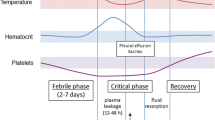Abstract
The immune pathogenesis of dengue involves antibody production, B cell and T cell response and various pro-inflammatory and anti-inflammatory cytokines. VEGF, a potent permeability enhancing cytokine, is thought to play a pivotal role in mediating plasma leakage in DHF. It is a member of growing family of related proteins that includes VEGF B, VEGF C, VEGF D and placental growth factor. It promotes angiogenesis and vascular integrity. In addition to its role in promoting endothelial permeability & proliferation, it may contribute to inflammation and coagulation. This study was undertaken to investigate the role of VEGF in the patients with dengue infection. Sera were collected from 106 patients with various grades of dengue illness and 40 healthy controls and tested for VEGF levels using commercial ELISA kits. Viral serotypes were detected using specific primers. The results showed very low levels of VEGF (3.493 ± 1.982 pg/ml) in healthy controls. Levels of VEGF were higher in patients with severe dengue (428.170 ± 224.61 pg/ml) as compared to patients with non severe dengue with and without warning signs (290.407 ± 167.17 pg/ml). Significant correlation (p < 0.001) was found between raised VEGF levels and thrombocytopenia and raised haematocrit levels. The VEGF profile patterns discovered between the different phases of illness indicate an essential role in dengue pathogenesis and with further studies may serve as predictive markers for progression of dengue fever to severe dengue infection.


Similar content being viewed by others
References
Benedict MQ, Levine RS, Hawley WA, Lounibos LP. Spread of the tiger: global risk of invasion by the mosquito Aedes albopictus. Vector Borne Zoonotic Dis. 2002;7(1):76–85.
Chakravarti A, Kumaria R. Circulating levels of tumour necrosis factor-α & interferon-γ in patients with dengue & dengue haemorrhagic fever during an outbreak. Indian J Med Res. 2006;123:25–30.
Clyde K, Jennifer LK, Eva H. Recent advances in deciphering viral and host determinants of dengue virus replication and pathogenesis. J Virol. 2006;80(3):11418–31.
Furuta T, Murao LA, Lan M, Hug NT, Huong VT. Association of mast cell-derived VEGF and proteases in Dengue shock syndrome. PloS Negl Trop Dis. 2012;6(2):e1505. doi:10.1371/journal.pntd.0001505
Gibbons RV, Vaughn DW. Dengue: an escalating problem. BMJ. 2002;324(7353):1563–6.
Grist NR. Aedes albopictus: the tyre—travelling tiger. J Infect. 1993;27:1–4.
Grist NR, Burgess NRH. Aedes and dengue. Lancet. 1994;343(8895):477.
Gubler DJ. The global pandemic of dengue/dengue haemorrhagic fever: current status & prospects for the future. Ann Acad Med. 1998;27(2):227–34.
Gubler DJ. Dengue and dengue haemorrhagic fever. Clin Microbiol Rev. 1998;11(3):480–96.
Gubler DJ, Clark GG. Community involvement in the control of Aedes aegypti. Acta Trop. 1996;61(2):169–79.
Guzmán MG, Kourí G, Valdés L, Bravo J, Vázquez S, Halstead SB. Enhanced severity of secondary dengue-2 infections: death rates in 1981 and 1997 Cuban outbreaks. Rev Panam Salud Publica. 2002;11(4):223–7.
Halstead SB. Observations related to pathogenesis of dengue haemorrhagic fever VI. Hypothesis and discussion. Yale J Biol Med. 1970;42:350–62.
Halstead SB. Pathogenesis of dengue: challenges to molecular biology. Science. 1988;239:476–81.
Halstead SB. Antibody, macrophages, dengue virus infection, shock and haemorrhage: a pathogenic cascade. Clin Infect Dis. 1989;11(4):s830–9.
Lanciotti R, Calisher C, Gubler DJ, Chang G, Vorndam V. Rapid detection and typing of dengue viruses from clinical samples by using reverse transcriptase–polymerase chain reaction. J Clin Microbiol. 1992;30:545–51.
Loke H, Bethell DB, Phuong CXT, Dung M, Schneider J, White NJ, Hill AV. Strong HLA class I—restricted T cell responses in dengue hemorrhagic fever: a double-edged sword? J Infect Dis. 2001;184(11):1369–73.
Perez AB, Sierra B, Garcia G, Aguirre E, Babel N, Alvarez M, Guzman MG. Tumor necrosis factor-alpha, transforming growth factor-β1, and interleukin-10 gene polymorphisms: implication in protection or susceptibility to dengue hemorrhagic fever. Hum Immunol. 2010;71(11):1135–40.
Rico-Hesse R. Molecular evolution and distribution of dengue viruses type 1 & 2 in nature. Virology. 1990;174(2):479–93.
Sabin AB. Research on dengue during world war II. Am J Trop Med Hyg. 1952;1(1):30–50.
Sathupan P, Khongphattanayothin A, Srisai J, Srikaen K, Poovorawan Y. The role of vascular endothelial growth factor leading to vascular leakage in children with dengue virus infection. Ann Trop Paediatr. 2007;27(3):179–84.
Sawano A, Iwai S, Sakurai Y, Ito M, Shitare K et al. VEGFR1 is a novel cell surface marker for the lineage of monocyte-macrophage in humans. Blood 2001;97:785–91.
Seet R, Chow A, Quekamy ML, Chan YH. Relationship between circulating vascular endothelial growth factor and its soluble receptors in adults with dengue virus infection: a case control study. Int J Infect Dis. 2009;13(5):248–53.
Srikiatkhachorn C, Kharon A, Endy TB. Virus-induced decline in soluble vascular endothelium growth factor receptor 2 is associated with plasma leakage in DHF. J Virol. 2007;81(4):1592–600.
Tseng C, Lohw S, Teng H. Elevated levels of plasma VEGF in patients with dengue hemorrhagic fever. FEMS Immunol Med Microbiol. 2005;43:99–102.
Author information
Authors and Affiliations
Corresponding author
Additional information
Preeti Thakur, Anita Chakravarti, Sunita Aggarwal, Beena Uppal and Preena Bhalla have contributed equally to this work.
Rights and permissions
About this article
Cite this article
Thakur, P., Chakravarti, A., Aggarwal, S. et al. Elevated levels of vascular endothelial growth factor in adults with severe dengue infection. VirusDis. 27, 48–54 (2016). https://doi.org/10.1007/s13337-015-0296-2
Received:
Accepted:
Published:
Issue Date:
DOI: https://doi.org/10.1007/s13337-015-0296-2




